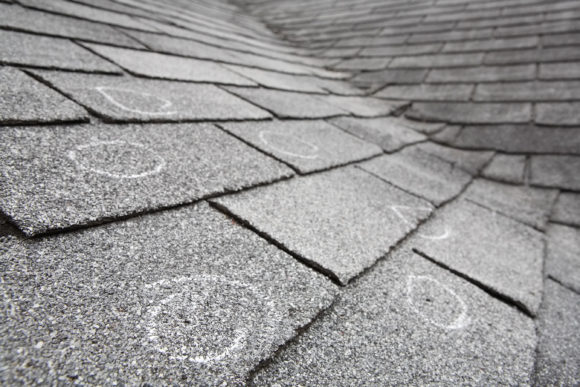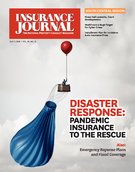Following a severe hailstorm in south Texas in 2012, insurers were beset with homeowner property lawsuits – sometimes after claims were paid and repairs were completed, according to an insurer trade group.
Since then, some insurance companies have seen hundreds of lawsuits being filed simultaneously immediately or sometimes months after a storm, the Insurance Council of Texas reported.
The ICT added that the suits have been filed despite data from the Texas Department of Insurance showing there were few property-related insurance complaints filed during 2013-2015.
Texas-based attorney Steve Badger with the firm Zelle LP has been tracking the development of these lawsuits. He expects that there will be some 7,000 hail damage lawsuits filed in Texas this year.
In an article published on Insurance Journal affiliate, ClaimsJournal.com, Badger wrote that from 2006 through 2011, Tarrant County alone had 12 storms with hail at least 1.75 inches in diameter. “But no more than 49 hail lawsuits were filed in any of those years. Compare that to 2014 in which 375 hail lawsuits were filed, and 2015 which saw 381 hail lawsuits filed. These statistics don’t lie – it has always hailed in Tarrant County, but only recently have we seen hail lawsuits total in the hundreds,” Badger wrote.
In his May 13, 2016, CJ column, “The Emerged Hail Risk: The Balanced Solutions,” Badger noted that in the first quarter of 2016, “almost 1700 hail lawsuits were filed across Texas. Significant numbers of lawsuits were filed in Hidalgo, Webb, Cameron, Dallas, Tarrant, Collin, Harris, Fort Bend, El Paso and Bexar counties. Many other counties are affected as well.”
Insurance companies are challenging many of the questionable lawsuits and ICT suggests that court actions may work to deter such litigation.
For instance, in early 2015, a Texas-based insurer prevailed in the first lawsuit to go to trial over claims from the two big hailstorms in 2012 in Hidalgo County.
The 12-member jury in Amaro v. National Lloyds found that National Lloyds Insurance Co. acted in good faith and appropriately processed the claim for damage presented by the insureds, Andrea and Martin Amaro, under the terms of the insurance policy.
An as recently as May 2016, a six-member jury in Houston denied a woman’s claim that her leaky roof was caused by a hail storm, the ICT said. Her claim was supported by a roofing expert who said the leak was the result of hail damage and the homeowner sought $46,000 in damages.
However, the Texas FAIR Plan, which insured the home, argued that the leaking roof was the result of long-term poor maintenance. The insurer also pointed out that the homeowner did not examine the roof until six months after the lawsuit was filed.
The jury deliberated for less than a minute before returning the verdict.
“I don’t think the jurors even sat down before making their decision,” said Lori Daves, of Jay Old and Associates, who defended the Texas FAIR plan in the case. “It was the quickest verdict I have ever been part of.”
Many of the hail lawsuits also have found their way into federal court where some have been dismissed after appraisals were completed, according to the ICT.
In one case, a federal judge in McAllen admonished a plaintiff’s attorney, asking him why he shouldn’t be sanctioned for bringing factually unsupported hail claims against insurer, the ICT said.
A National Problem
While Texas leads the way in the number of hail claims filed annually, other states are not immune to disastrous hail weather events and rising claim costs.
Citing data compiled by the Verisk A-PLUS property database, the National Insurance Crime Bureau said while hail damage claims nationwide decreased by an overall 21 percent from 2013 to 2015, costs associated with those claims has increased significantly.
There were 720,473 hail damage claims filed in 2013, the NICB reported. That number increased in 2014 to 824,325 and dropped in 2015 to 572,182 claims. But average claim severity rose by 65 percent during the six-year period 2008 through 2013, compared with the previous six years.
A total of 2,116,980 hail loss claims were processed from Jan. 1, 2013, through Dec. 31, 2015. During this period, the top five states generating hail damage claims were Texas (394,572), Colorado (182,591), Nebraska (148,346), Kansas (127,963) and Illinois (120,513). The top five months, on average, when the most hail loss claims were reported during this period were May (165,087), April (149,040), June (129,085), March (61,072) and July (55,650).
Claims Journal Editor Denise Johnson reported in late May that hail damage litigation is on the rise in other states – such as Colorado, Oklahoma and Minnesota – that routinely experience large hail events.
A Failed Legislative Fix
The Texas legislature meets every two years. In its most recent Texas legislative session – 2015 –a measure sought by the insurance industry that its proponents said would help rein in litigation related to property insurance claims died in the House of Representatives.
Passed by the Senate on April 30, 2015, Senate Bill 1628 by Sen. Larry Taylor of Friendswood, an insurance agent and agency owner, would have, among other things, limited the time frame in which property damage claims and lawsuits over those claims could be filed.
It also would have granted immunity from liability to insurance company adjusters, insurance agents and others working on behalf of an insurance company in a claim dispute. All liability instead would be held by the insurer under the bill’s provisions.
In 2011 as a state representative, Taylor successfully sponsored similar legislation aimed at curbing future lawsuits against the Texas Windstorm Insurance Association, which was overwhelmed by litigation over its handling of claims in the aftermath of Hurricane Ike.
But in public hearings, petitions and letters to lawmakers, consumer advocates and business interests spoke loudly against SB 1628, saying it was overreaching and that it would exclude policy benefits and deny the insured the benefit of the contract.
Proponents of the legislation say they expect to try again in 2017.
Was this article valuable?
Here are more articles you may enjoy.



 AT&T Says Data From Around 109M Customer Accounts Illegally Downloaded
AT&T Says Data From Around 109M Customer Accounts Illegally Downloaded  What Happened to Reinsurance ‘Class of 2023’? Hard Market Defies Age-Old Patterns.
What Happened to Reinsurance ‘Class of 2023’? Hard Market Defies Age-Old Patterns.  Allstate Seeking 34% Rate Hike on California Homeowners Insurance
Allstate Seeking 34% Rate Hike on California Homeowners Insurance  The Battle Over J&J’s Bankruptcy Plan to End Talc Lawsuits
The Battle Over J&J’s Bankruptcy Plan to End Talc Lawsuits 


